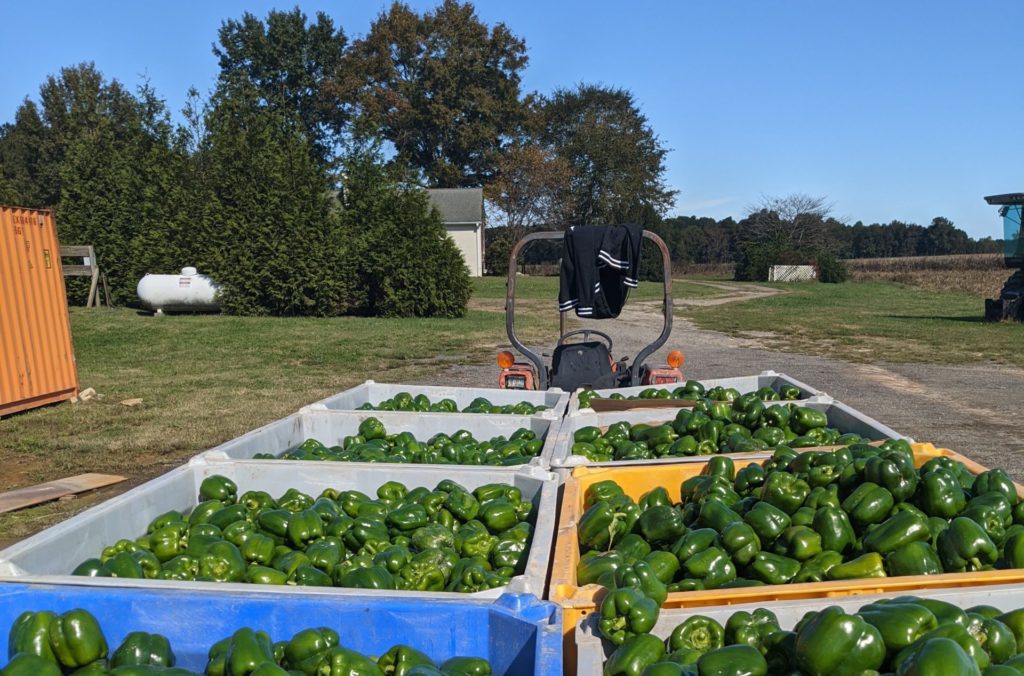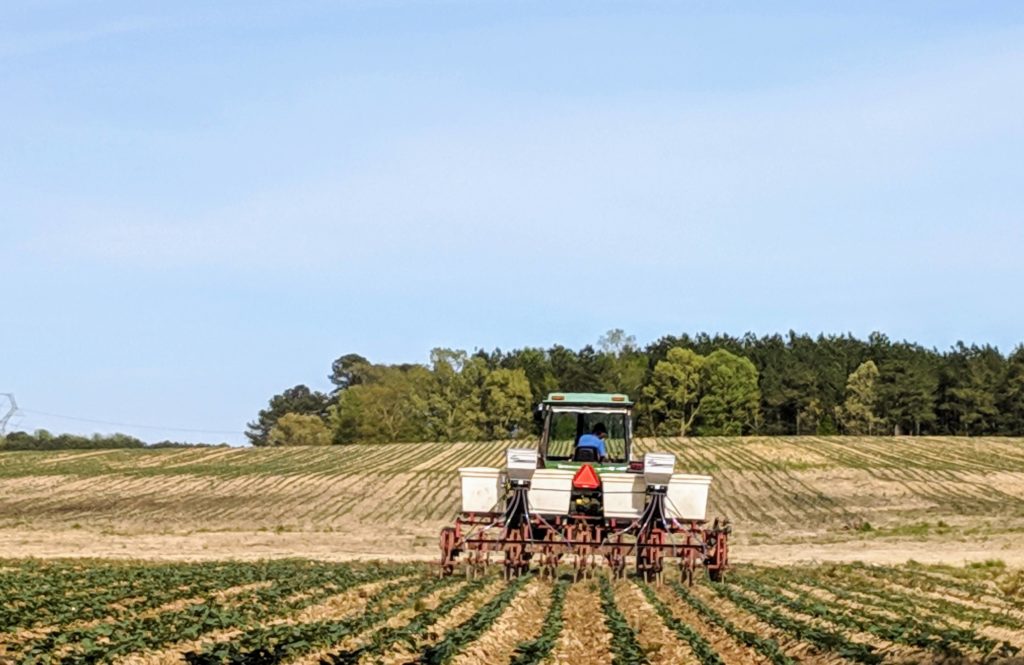
Jun 2, 2021
Old Dominion Farms transitions from tobacco to organic produce
Tracing its farming heritage to the 17th century, Old Dominion Organic Farms is one of North America’s oldest farming operations. In its 12th generation of operation, the southeast Virginia farm has successfully transitioned from growing a traditional southern crop to organic produce.
Since 1654, the Dundas, Virginia, operation grew tobacco. Jordan Brandon, owner, is the first generation in the last five generations of Brandons who has not grown tobacco.
In southern Virginia and northern North Carolina, Old Dominion grows on about 1,700 acres of totally organically certified land. All of the land is tillable, and fresh organic produce is grown on about 500 acres.
Old Dominion’s production area includes southern Virginia northeast to the James River, and south into northern North Carolina near Lake Gaston. Old Dominion’s primary crops are broccoli and cabbage during the spring and fall, summer squash, bell peppers and cucumbers, as well as field corn and soybeans. It also grows tomatoes, cauliflower, green beans, beets, carrots, pumpkins, acorn squash, butternut squash, pumpkins and organic alfalfa. Parker Farms and Hollar & Greene Produce Co. market most of Old Dominion’s organic produce.
“With half of the U.S. population within a day’s drive from the farm, organic produce became the obvious choice as it could be on store shelves 24 hours after coming from the field,” said Brandon.
After graduating from Virginia Military Institute and earning a Master’s degree in mechanical engineering from Virginia Tech, Brandon worked as a mechanical engineer with Raytheon Systems in the Washington, D.C., area. He designed aerospace hardware for five years before returning to the family farm in Dundas in 2006 to take over tobacco production.
Trying transition

Brandon expanded acreage, but envisioning a dimming tobacco market, he became concerned about tobacco’s uncertainty. Brandon began to transition land into organic tobacco and row crops, with a focus on moving to organic produce.
The numbers tell the story. In 2001, Virginia produced 63 million pounds of tobacco. In 2020, production decreased to 26 million pounds. In 2020, the average sales price was $1.90 a pound, compared to $2.80 in 2001 (inflation-adjusted to 2020 dollars), according to Brandon.
Brandon has grown organic produce since 2015. Organic vegetable acreage increased from 20 acres in 2015 to 200 acres in 2018. All of Old Dominion’s produce is certified organic.
Old Dominion’s season begins in January with seeding of transplants in the greenhouse. The cole crop transplants are planted in March, with harvest beginning the end of May and first of June. With slight overlap, Old Dominion’s summer vegetables are planted in early May. Staggered planting and harvesting schedules of squash, zucchini, peppers, eggplant and cucumbers ensures consistent volume. Summer vegetables harvest from June 1 to the region’s first hard frost, which usually strikes in early November.
Meanwhile, the summer vegetables are still producing and Old Dominion starts its second season of cole crops, including broccoli and cabbage. The transplants are seeded in mid-July, planted from early August through September and begin harvesting in late October.
Entering organic

Old Dominion entered organic for a number of reasons. Organic production creates another barrier to entry for the competition, thus discouraging other growers from competing in the market.
“Organic produce appeared to be a less volatile market with many barriers to entry, which would act to subdue any mass influx of producers, such as those seen in the hemp market in the past two years or the increases the grain acreage sees whenever there is an uptick in pricing,” Brandon said.
As fields must be free of chemical inputs for three years prior to harvest, this also keeps a lid on the unexpected vast changes in the markets. Because of the demand for locally grown organic produce, it was a much easier market to enter into on a small – and more inefficient – scale.
“More organic land makes rotations easier, gives acres to set aside to try new crops on, and creates a higher return per acre than conventional crops,” said Brandon.
Policy, trade agreements, the costs of implementing food safety requirements and organic input costs are among the many issues challenging organic growers.
“Production of specialty crops is a labor-intensive venture,” said Brandon. “While farmers in the region are accustomed to sourcing labor, the focus has always been on tobacco and row crops. The cost of labor is high, and there have been concerns about sourcing labor with closed borders, restricted migration and the COVID pandemic.”
Growing pains

Growing organic produce in the Mid-Atlantic is different from other Southeast growing regions.
The East Coast brings challenges of high humidity and long periods of rainfall. Aside from a few specific insects, the disease is the most difficult issue to control.
The region enjoys slightly milder summers, but cooler temperatures in the fall and the spring. Winter can be mild, but there is always the chance of a frost later in the season. Spring is usually wet and can be warmer or cooler. July tends to be hot and dry, with the fall offering some warmer temperatures into November.
Because Old Dominion doesn’t farm as far south as Georgia and Florida growers, the operation is more centralized to the large markets. “Diversification is extremely important,” said Brandon. “Because of variations in weather, soil, growers’ expertise and the demands of the market, we work to have a variety of products ready for our customers. This requires precision and lots of planning.”
Southern Virginia hasn’t historically been known for commercial produce. Because of the lack of historical data for produce as well as a lack of information on organic production, production techniques were learned by trial and error.
“We learn a great deal with each crop, implement the needed changes and make improvements for the following growing cycle,” said Brandon.
New production techniques almost never happen, Brandon observed. “Techniques are brought back from prior times, different regions, or transferred from different crops,” he said. “Rarely is a novel way of farming created. Most of what I see on farms is simply a different application of a known technique. In the case of what vendors deem as groundbreaking advancement in technology in agriculture, it has simply been application of now mature technology on existing techniques.”
While drones can provide a quick overview of a field, they aren’t well suited to scout vegetable crops in the detailed level needed for produce, noted Brandon. Drone technology seems to work better for field crops instead of high value produce crops. As technology advances, Brandon said he suspects this will change.
Where technology has made a difference is in expanded cell phone service. While this has created the obvious benefit of easier contact with people in the field, the bigger benefit for Old Dominion is in leveraging the ability to communicate in real time with its web-based production documentation system.
Growing organics has become slightly easier with more OMRI (Organic Materials Review Institute) listed inputs to control pests and disease. Also, with more research being conducted on organic growing methods, growers possess more information on which to base decisions, said Brandon.
Deep farming history
 The first generation of Brandons, the John Brandon family, moved from the United Kingdom in the mid 1650s, initially settling in the Nansemond area of Suffolk, Virginia. He and his son farmed and later relocated to Danville, Virginia, in the west-central part of the state and Virginia’s tobacco growing center at the time.
The first generation of Brandons, the John Brandon family, moved from the United Kingdom in the mid 1650s, initially settling in the Nansemond area of Suffolk, Virginia. He and his son farmed and later relocated to Danville, Virginia, in the west-central part of the state and Virginia’s tobacco growing center at the time.
James Brandon, Jordan Brandon’s great grandfather, moved from Danville to Dundas, southwest of Richmond, Virginia, in search of good farmland for tobacco production.
Sidney James Brandon, Sr., Jordan Brandon’s grandfather who died in 2016, and Sidney James Brandon, Jr., Jordan Brandon’s father, grew tobacco and also raised cattle and hogs.
Jordan Brandon’s siblings are involved in other vocations. His mother, who was instrumental in running the farm with his father, is a retired radiologist. Jordan’s brother is a radiologist while his sister is a partner in a Norfolk, Virginia, law firm.
The deep family history and farming longevity resonates with Brandon. In context, it doesn’t really matter to him as drivers see signs announcing Virginia’s many centennial farms. “It’s a feel-good point,” said Brandon. “If the generations before me hadn’t done what they did, I would not be in a position to do this. I wouldn’t have had much of this already at my fingertips and some certainty about stepping out and taking risks. I feel fortunate to still be able to do what I’ve been doing for generations and carrying on that tradition.”






